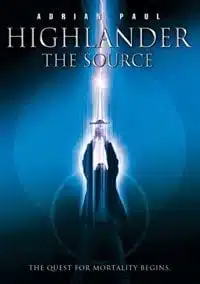
Early on in Highlander: The Source, a character remarks, “Over the past week, the planets of our solar system have moved outside their orbital paths and are coming into alignment. I mean, do you know how unusual that is?”
Unusual, you say? Two-headed kittens are unusual. My neighbors not getting liquored up and shooting guns at 1:30AM., that’s unusual. Screenwriters writing about the cosmos without learning even the basics of astronomy, on the other hand, isn’t unusual at all.
By the time he exclaims, “Literally millions of celestial bodies from here to the central sun of our galaxy are lining up”, the scientific impossibilities are coming so fast and furious that you’re practically dizzy. Lord, just think if this were an actual science fiction movie, the damage they could do. But let’s face it: it’s about right for the Highlander films, which have made a cottage industry of testing fans’ patience, not just with pseudo-science nonsense like syzygy on a galactic scale, but also with its ham-handed treatment of its own mythology.
The Highlander series has always been consistent about at least one thing: its inconsistency. I guess that’s only natural when the need for sequels clashes with a storyline that proclaims “there can be only one”, but it’s awfully annoying.
The first Highlander introduced us to Connor MacLeod (Christopher Lambert), one of a race of Immortals who battle across the centuries, taking each other’s heads in pursuit of “the Prize”. Highlander wrapped that storyline up quite nicely, until Highlander II: The Quickening introduced a bunch of hooey about the Immortals actually being aliens. Over the course of various alternate versions, Highlander II pretty much lets you pick your own ending — none of them any count — but it still wraps up this whole Prize thing by the time it’s done.
Oh, but wait. Highlander III: The Final Dimension revealed that this great cosmic force that spanned centuries and even the vastness of space could apparently be fooled by the fact that some Immortals had apparently been buried underground in the 16th Century. So here we went again, with blades flashing and heads rolling. Yet again, the Prize was safely in hand by story’s end.
While all of this was going on, there was also the Highlander TV series as well, featuring Connor’s kinsman Duncan (Adrian Paul), who had weekly Immortal problems all his own. This is where the continuity got really cloudy, if you can imagine it getting any murkier. Eventually, the show pretty much gave up any pretense of fitting in. So we were “gifted” with Highlander: Endgame, in which the torch was officially passed to Duncan’s storyline. Which still didn’t help continuity when Connor, who had won the Prize in the first installment, dies and spiritually inhabits Duncan.
To its credit, Highlander: The Source attempts to salvage what continuity it can, setting itself in your typical post-civilization future characterized by chaos, grim landscapes, and cannibals. The aforementioned planets are aligning, and MacLeod gets mixed up with his mortal wife, Anna (Thekla Reuten), and three other Immortals — Methos (Peter Wingfield), Giovanni (Thom Fell), and Reggie (Stephen Wight)– on the search for a mystical source of the Immortals’ power.
Only problem is, they’re being stalked by the source’s Guardian (Christian Solimeno), who moves in quick-time fashion — much like the jittery ghosts from recent Japanese horror films — and dresses like he’s friends with the Gimp from Pulp Fiction. A fierce hunter and fighter, the Guardian pursues his own mysterious agenda while tracking MacLeod and company on their quest.
To be honest, though, it’s not much of a quest. A boat ride and a hotwired car, and they’re pretty much there. The group’s only real altercations result from Duncan’s nobility as they stop to help people in peril. Granted, this establishes Duncan’s worthiness as the film progresses towards its inevitable and formulaic conclusion, but the whole thing feels fairly average. Heck, for a group of seasoned warriors with hundreds, if not thousands, of kills between them, they don’t even fight terribly well. Not that you can really tell, since the fight scenes are usually a confusing, see-sawing jumble of slow-motion and quicktime movements.
The film obviously seeks to set some continuity straight, or at least to re-establish the franchise’s bearings. To a large extent, this comes down to the fact that everything that’s gone before — all the beheadings, the seemingly endless or restarting Gatherings, and so on — stems from a misunderstood prophecy. “There can be only one”, it turns out, doesn’t mean what everyone thought it did.
We know these things because we’re told, courtesy of a loooong narration at the end of the film during a decidedly New Agey, cheesy ending. The film paints itself into such a corner by the end that it reverts to a “tell, don’t show” approach that essentially recaps the entire film, draining away whatever precious flickers of energy the film had accumulated. As a means of pulling the Highlander films back into alignment, it’s certainly unusual — but not terribly convincing.

